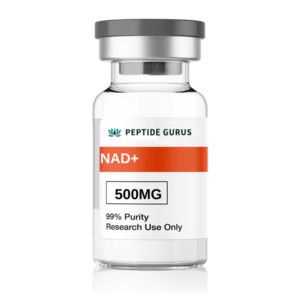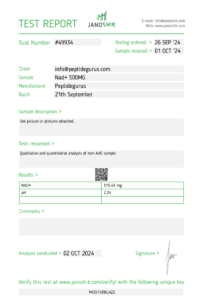In recent years, the study ofNAD+ peptidehas emerged as a fascinating area of research, especially in the context of neurodegenerative diseases. NAD+ (Nicotinamide Adenine Dinucleotide) peptide, an oxidized form of NADH, plays crucial roles in various biological processes, and its potential impact on neurodegenerative conditions has caught the attention of the scientific community.
Understanding NAD+ Peptide
NAD+ is not just a simple molecule; it is involved in over 500 enzymatic reactions within the body. Endogenously, it is synthesized through a de novo pathway that starts with the amino acid tryptophan. The process involves several enzymatic steps and key constituents such as tryptophan, nicotinamide, nicotinic acid, nicotinamide riboside, and nicotinamide mononucleotide. As a coenzyme, NAD+ participates in redox reactions, shuttling electrons from one reaction to another, which is fundamental for intracellular energy transfer. It also has functions in extracellular domains in certain situations. It might be involved in enzyme modulation, posttranslational modifications of proteins, and even intercellular communication. NAD+ has been found to be released from neurons in areas like blood vessels, the urinary bladder, the colonic tract, and specific neural regions in the brain.
The Link to Neurodegenerative Diseases
Neurodegenerative diseases, such as Alzheimer’s, Parkinson’s, and Huntington’s, are characterized by the progressive loss of neuronal structure and function. A common feature in many of these diseases is a decline in NAD+ levels in the affected tissues. For example, in Alzheimer’s disease, studies have shown that lower NAD+ concentrations are associated with increased oxidative stress and inflammation in the brain. Mitochondrial dysfunction, which is a hallmark of neurodegenerative diseases, is also closely related to NAD+ levels. Mitochondria, often referred to as the powerhouses of the cell, are not only responsible for energy production but also play roles in intracellular signaling, innate immunity regulation, and stem cell dynamics. As we age, mitochondrial function deteriorates, and this is associated with a decrease in NAD+ levels. Some research indicates that restoring NAD+ levels through dietary supplements or other means might potentially reverse some of the age – linked mitochondrial degeneration, which could have implications for neurodegenerative disease treatment.

บทบาทและคําแนะนําของ FDA ในการวิจัยเปปไทด์
องค์การอาหารและยา (สํานักงานคณะกรรมการอาหารและยา) ได้จัดทําร่างคําแนะนําเกี่ยวกับการพิจารณาทางเมาสัชวิทยาทางคลินิกสําหรับผลิตภัณฑ์ยาเปปไทด์ คําแนะนํานี้มีความสําคัญต่อการพัฒนาการบําบัดโดยใช้เปปไทด์ รวมถึงการรักษาที่เกี่ยวข้องกับเปปไทด์ NAD+ คําแนะนําของ FDA มุ่งเน้นไปที่หลายแง่มุม เช่น ความบกพร่องของตับ ปฏิกิริยาระหว่างยา - ยา (DDI) ความเสี่ยงในการยืดอายุ QT และความเสี่ยงในการเกิดภูมิคุ้มกัน ซึ่งทั้งหมดนี้มีความสําคัญเมื่อพิจารณาการพัฒนาเปปไทด์ NAD+ สําหรับโรคระบบประสาท
-
ความบกพร่องของตับ: Peptides are mainly degraded by proteases. However, specific peptide characteristics can lead to hepatic impairment. For example, if a peptide has substantial hepatic metabolism (more than 20%), it may pose an increased risk of plasma exposure. Structural modifications, like in cyclic peptides, can make them susceptible to liver enzyme metabolism. The FDA requires detailed studies on how hepatic impairment might affect the metabolism and clearance of NAD+ peptides.
-
ยา – ปฏิกิริยาระหว่างยา: Generally, peptide drug products are not CYP enzyme substrates as they are metabolized by proteolytic enzymes. But for some structurally modified peptides, like cyclic peptides, there can be interactions with CYP metabolism or transporters. In the case of NAD+ peptides, if they are being developed in combination with other drugs for neurodegenerative disease treatment, understanding potential DDIs is essential.
-
Immunogenicity Risk: ผลิตภัณฑ์ยาเปปไทด์ รวมถึงเปปไทด์ NAD+ อาจมีความเสี่ยงต่อการเกิดภูมิคุ้มกัน ผลิตภัณฑ์ – ปัจจัยเฉพาะ (เช่น ขนาดโมเลกุล โครงสร้าง และความบริสุทธิ์) กระบวนการ – ปัจจัยเฉพาะ (โปรตีนและสิ่งสกปรกของเซลล์โฮสต์) หัวข้อ – ปัจจัยเฉพาะ (สถานะของโรคและความบกพร่องทางพันธุกรรม) และการศึกษา – ปัจจัยเฉพาะ (สูตรการให้ยาและเส้นทางการบริหาร) ล้วนต้องได้รับการประเมินอย่างรอบคอบ องค์การอาหารและยาแนะนําแนวทางแบบแบ่งชั้นสําหรับการประเมินการสร้างภูมิคุ้มกัน รวมถึงการพัฒนาการทดสอบสําหรับการตรวจหาแอนติบอดีต่อต้านยา (ADA) การประเมินไตเตอร์ ADA และผลกระทบต่อเภสัชจลนศาสตร์และเภสัชพลศาสตร์ และการตรวจสอบทั้งภายในและระหว่างการเปรียบเทียบอาสาสมัคร
ผลิตภัณฑ์ NAD+ เปปไทด์ของเรา
Our NAD+ peptide product comes in a 500 mg lyophilized powder form in a 5 ml vial. It has a high purity of ≥ 99%. The product has the chemical formula C21H27N7O14P2, a PubChem CID of 5893, and a CAS number of 53 – 84 – 9, with a molecular weight of approximately 663.43 g/mol. Synonyms for NAD+ include nicotinamide adenine dinucleotide, coenzyme I, β – NAD, and NADH. It is important to note that the product requires reconstitution with a solvent such as bacteriostatic water. It should be stored at – 10 °C, sealed, away from heat, light, and moisture to maintain its quality. This product is designed for research purposes and can be a valuable tool in further exploring the potential of NAD+ peptides in neurodegenerative disease research, helping scientists to better understand its mechanisms of action and potential therapeutic applications within the framework of FDA’s regulations.
คําถามที่พบบ่อย
-
Q: ฉันสามารถรับประทานผลิตภัณฑ์เปปไทด์ NAD+ โดยตรงเป็นอาหารเสริมเพื่อป้องกันโรคระบบประสาทได้หรือไม่?
A: ปัจจุบันผลิตภัณฑ์ NAD+ peptide ของเรามีไว้สําหรับการวิจัยเท่านั้น แม้ว่า NAD+ จะแสดงศักยภาพในการวิจัยโรคระบบประสาท แต่ก็ยังไม่ได้รับการอนุมัติให้เป็นอาหารเสริมสําหรับผู้บริโภคเพื่อป้องกันหรือรักษา องค์การอาหารและยามีกฎระเบียบที่เข้มงวดเกี่ยวกับการอนุมัติยาและอาหารเสริม และจําเป็นต้องมีการวิจัยเพิ่มเติมเพื่อกําหนดความปลอดภัยและประสิทธิภาพสําหรับการบริโภคของมนุษย์ในบริบทนี้
-
Q: สภาพการเก็บรักษาส่งผลต่อคุณภาพของผลิตภัณฑ์เปปไทด์ NAD+ อย่างไร?
A: The NAD+ peptide should be stored at – 10 °C, away from heat, light, and moisture. Heat can accelerate chemical reactions that may degrade the peptide. Light can also cause photochemical reactions, altering the structure of the peptide. Moisture can lead to hydrolysis, breaking down the peptide into smaller fragments. Proper storage ensures that the peptide maintains its high purity and integrity for reliable research results.
-
Q: Are there any potential side effects of usingNAD+ peptidein research on cell cultures or animal models for neurodegenerative diseases?
A: ในการตั้งค่าการวิจัย ผลข้างเคียงที่อาจเกิดขึ้นอาจแตกต่างกันไปขึ้นอยู่กับปัจจัยต่างๆ เช่น ขนาดที่ใช้ ชนิดของแบบจําลองสัตว์ หรือประเภทของการเพาะเลี้ยงเซลล์ ตัวอย่างเช่น ในบางกรณี เปปไทด์ NAD+ ในปริมาณสูงอาจนําไปสู่การเปลี่ยนแปลงเส้นทางการเผาผลาญในเซลล์ ซึ่งอาจถูกตีความผิดว่าเป็นการตอบสนองทางสรีรวิทยาปกติ ในแบบจําลองสัตว์ อาจส่งผลต่อการทํางานของอวัยวะอื่นๆ เนื่องจากการไหลเวียนของระบบ อย่างไรก็ตาม ผลกระทบเหล่านี้ยังคงอยู่ระหว่างการศึกษา และการทําความเข้าใจเป็นส่วนหนึ่งของกระบวนการวิจัยเพื่อกําหนดการใช้เปปไทด์ NAD+ อย่างปลอดภัยและมีประสิทธิภาพในบริบทของการวิจัยโรคระบบประสาท

